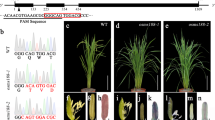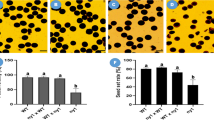Abstract
Key message
Phenotype identification, expression examination, and function prediction declared that the anther-preferential expressing gene PMR may participate in regulation of male gametophyte development in rice.
Abstract
Male germline development in flowering plants produces the pair of sperm cells for double fertilization and the pollen mitosis is a key process of it. Although the structural features of male gametophyte have been defined, the molecular mechanisms regulating the mitotic cell cycle are not well elucidated in rice. Here, we reported an anther-preferential expressing gene in rice, PMR (Pollen Mitosis Relative), playing an essential role in male gametogenesis. When PMR gene was suppressed via RNAi, the mitosis of microspore was severely damaged, and the plants formed unmatured pollens containing only one or two nucleuses at the anthesis, ultimately leading to serious reduction of pollen fertility and seed-setting. The CRISPR mutants, pmr-1 and pmr-2, both showed the similar defects as the PMR-RNAi lines. Further analysis revealed that PMR together with its co-expressing genes were liable to participate in the regulation of DNA metabolism in the nucleus, and affected the activities of some enzymes related to the cell cycle. We finally discussed that unknown protein PMR contained the PHD, SWIB and Plus-3 domains and they might have coordinating functions in regulation pathway of the pollen mitosis in rice.







Similar content being viewed by others
References
An FM, Chan MT (2012) Transcriptome-wide characterization of miRNA-directed and non-miRNAdirected endonucleolytic cleavage using Degradome analysis under low ambient temperature in Phalaenopsis aphrodite subsp. formosana. Plant Cell Physiol 53:1737–1750
Bennett-Lovsey R, Hart SE, Shirai r, Mizuguchi K (2002) The SWIB and the MDM2 domains are homologous and share a common fold. Bioinformaticsdiscovery Note 18:626–630
Bochar DA, Savard J, Wang W, David W, Lafleur PM, Cote J, Shiekhattar AR (2000) Transcriptional activation by the PHD finger is inhibited through an adjacent leucine zipper that binds 14-3-3 proteins. Proc Natl Acad Sci 97:1038–1043
Brownfield L, Hafidh S, Durbarry A, Khatab H, Sidorova A, Doerner P, Twell D (2009) Arabidopsis DUO POLLEN3 is a key regulator of male germline development and embryogenesis. Plant Cell 21:1940–1956
Chu ZH, Yuan M, Yao LL, Ge XJ, Yuan B, Xu CG, Li XH, Fu BY, Li ZK, Bennetzen JL, Zhang QF, Wang SP (2006) Promoter mutations of an essential gene for pollen development result in disease resistance in rice. Gene Dev 20:1250–1255
Cuttino LW, Arthur DW, Keisch M, Jenrette JM, Prestidge BR, Quiet CA, Vicini FA, Rescigno J, Wazer DE, Patel R (2006) Multi-institutional experience using the MammoSite radiation therapy system (RTS) in the treatment of early-stage breast cancer: 2 year results. Int J Radiat Oncol 66:S30–S31
de Jong RN, Truffault V, Diercks T, AB E, Daniels MA, Kaptein R, Folkers GE (2008) Structure and DNA binding of the human Rtf1 Plus3 domain. Structure 16:149–159
Durbarry A, Vizir I, Twell D (2005) Male germ line development in Arabidopsis. duo pollen mutants reveal gametophytic regulators of generative cell cycle progression. Plant Physiol 137:297–307
Endo M, Nakayama S, Umeda-Hara C, Ohtsuki N, Saika H, Umeda M, Toki S (2012) CDKB2 is involved in mitosis and DNA damage response in rice. Plant J 69:967–977
Fujita M, Horiuchi Y, Ueda Y, Mizuta Y, Kubo T, Yano K, Yamaki S, Tsuda K, Nagata T, Niihama M, Kato H, Kikuchi S, Hamada K, Mochizuki T, Ishimizu T, Iwai H, Tsutsumi N, Kurata N (2010) Rice expression atlas in reproductive development. Plant Cell Physiol 51:2060–2081
Guo J-X, Liu Y-G (2012) Molecular control of male reproductive development and pollen fertility in RiceF. J Integr Plant Biol 54:967–978
Gusti A, Baumberger N, Nowack M, Pusch S, Eisler H, Potuschak T, De Veylder L, Schnittger A, Genschik P (2009) The Arabidopsis thaliana F-Box protein FBL17 is essential for progression through the second mitosis during pollen development. Plos One 4
Halbach T (2000) Transcriptional activation by the PHD finger is inhibited through an adjacent leucine zipper that binds 14-3-3 proteins. Nucleic Acids Res
Han MJ, Jung KH, Yi G, Lee DY, An G (2006) Rice immature pollen 1 (RIP1) is a regulator of late pollen development. Plant Cell Physiol 47:1457–1472
Hu YF, Liu DN, Zhong XC, Zhang CJ, Zhang QF, Zhou DX (2012) CHD3 protein recognizes and regulates methylated histone H3 lysines 4 and 27 over a subset of targets in the rice genome. P Natl Acad Sci USA 109:5773–5778
Li H, Yuan Z, Vizcay-Barrena G, Yang CY, Liang WQ, Zong J, Wilson ZA, Zhang DB (2011) PERSISTENT TAPETAL CELL1 encodes a PHD-finger protein that is required for tapetal cell death and pollen development in rice. Plant Physiol 156:615–630
Ling S, Chen CS, Wang Y, Sun XC, Lu ZH, Ouyang YD, Yao JL (2015) The mature anther-preferentially expressed genes are associated with pollen fertility, pollen germination and anther dehiscence in rice. BMC Genomics 16
Liu JJ, Zhang YY, Qin GJ, Tsuge T, Sakaguchi N, Luo G, Sun KT, Shi DQ, Aki S, Zheng NY, Aoyama T, Oka A, Yang WC, Umeda M, Xie Q, Gu HY, Qu LJ (2008) Targeted degradation of the cyclin-dependent kinase inhibitor ICK4/KRP6 by RING-type E3 ligases is essential for mitotic cell cycle progression during Arabidopsis gametogenesis. Plant Cell 20:1538–1554
Loewith R, Meijer M, Lees-Miller SP (2000) Three yeast proteins related to the human candidate tumor suppressor p33ING1 are associated with histone acetyltransferase activities. Mol Cell Biol 3807–3816
Luo G, Gu HY, Liu JJ, Qu LJ (2012) Four closely-related RING-type E3 ligases, APD1-4, are involved in pollen mitosis II regulation in Arabidopsis. J Integr Plant Biol 54:814–827
Ma H (2005) Molecular genetic analyses of microsporogenesis and micro grametogenesis in flowering plants. Annu Rev Plant Biol
Matsubara K, Yamanouchi U, Nonoue Y, Sugimoto K, Wang ZX, Minobe Y, Yano M (2011) Ehd3, encoding a plant homeodomain finger-containing protein, is a critical promoter of rice flowering. Plant J Cell Mol Biol 66:603–612
Orthwein A, Fradet-Turcotte A, Noordermeer SM, Canny MD, Brun CM, Strecker J, Escribano-Diaz C, Durocher D (2014) Mitosis inhibits DNA double-strand break repair to guard against telomere fusions. Science 344:189–193
Pena PV, Musselman CA, Kuo AJ, Gozani O, Kutateladze TG (2009) NMR assignments and histone specificity of the ING2 PHD finger. Magn Reson Chem 47:352–358
Qi YB, Liu QL, Zhang L, Mao BZ, Yan DW, Jin QS, He ZH (2014) Fine mapping and candidate gene analysis of the novel thermo-sensitive genic male sterility tms9-1 gene in rice. Theor Appl Genet 127:1173–1182
Qin S, Jin L, Zhang JH, Liu L, Ji P, Wu MA, Wu JH, Shi YY (2011) Recognition of unmodified histone H3 by the first PHD finger of Bromodomain-PHD finger protein 2 provides insights into the regulation of histone acetyltransferases monocytic leukemic zinc-finger protein (MOZ) and MOZ-related factor (MORF). J Biol Chem 286:36944–36955
Saksouk N, Avvakumov N, Champagne KS, Hung T, Doyon Y, Cayrou C, Paquet E, Ullah M, Landry AJ, Cote V, Yang XJ, Gozani O, Kutateladze TG, Cote J (2009) HBO1 HAT complexes target chromatin throughout gene coding regions via multiple PHD finger interactions with histone H3 Tail. Mol Cell 33:257–265
Song Y, Chen Q, Ci D, Zhang D (2013) Transcriptome profiling reveals differential transcript abundance in response to chilling stress in Populus simonii. Plant Cell Rep 32:1407–1425
Tao JY, Zhang LR, Chong K, Wang T (2007) OsRAD21-3, an orthologue of yeast RAD21, is required for pollen development in Oryza sativa. Plant J 51:919–930
Wang W, Xue Y (1996) Diversity. and specialization of mammalian SWI/SNF complexes. Gene Dev 2117–2130
Wang L, Xie W, Chen Y, Tang W, Yang J, Ye R, Liu L, Lin Y, Xu C, Xiao J, Zhang Q (2010) A dynamic gene expression atlas covering the entire life cycle of rice. Plant J Cell Mol Biol 61:752–766
Wang P, Qi M, Barboza P, Leigh MB, Ungerfeld E, Selinger LB, McAllister TA, Forster RJ (2011) Isolation of high-quality total RNA from rumen anaerobic bacteria and fungi, and subsequent detection of glycoside hydrolases. Can J Microbiol 57:590–598
Wang X, Zhou W, Lu Z, Ouyang Y, O CS, Yao J (2015) A lipid transfer protein, OsLTPL36, is essential for seed development and seed quality in rice. Plant Sci 239:200–208
Wu CY, Li XJ, Yuan WY, Chen GX, Kilian A, Li J, Xu CG, Li XH, Zhou DX, Wang SP, Zhang QF (2003) Development of enhancer trap lines for functional analysis of the rice genome. Plant J 35:418–427
Yin LL, Xue HW (2012) The MADS29 transcription factor regulates the degradation of the nucellus and the nucellar projection during rice seed development. Plant Cell 24:1049–1065
Zhang DB, Wilson ZA (2009) Stamen specification and anther development in rice. Chin Sci Bull 54:2342–2353
Zhang DS, Liang WQ, Yin CS, Zong J, Gu FW, Zhang DB (2010) OsC6, encoding a lipid transfer protein, is required for postmeiotic anther development in rice. Plant Physiol 154:149–162
Zhu YY, Rowley MJ, Bohmdorfer G, Wierzbicki AT (2013) A SWI/SNF chromatin-remodeling complex acts in noncoding RNA-mediated transcriptional silencing. Mol Cell 49:298–309
Zou W, Yan JY, Zhao NH, Niu SZ, Huang XW (2015) A novel role for the alcohol sensitive ring/PHD finger protein Asr1p in regulating cell cycle mediated by septin-dependent assembly in yeast. Biochem Bioph Res Co 458:208–213
Acknowledgements
We thank Prof. Honghong Hu and Yidan Ouyang for their helpful suggestions and revision. This research received the support of a grant from the National Natural Science Foundation of China (Grant No.: 31570321). The funders had no role in study design, data collection and analysis, decision to publish, or preparation of the manuscript.
Author information
Authors and Affiliations
Corresponding author
Ethics declarations
Conflict of interest
The authors declare that they have no conflict of interest.
Additional information
Communicated by Da-Bing Zhang.
Electronic supplementary material
Below is the link to the electronic supplementary material.
Rights and permissions
About this article
Cite this article
Liu, Y., Xu, Y., Ling, S. et al. Anther-preferential expressing gene PMR is essential for the mitosis of pollen development in rice. Plant Cell Rep 36, 919–931 (2017). https://doi.org/10.1007/s00299-017-2123-2
Received:
Accepted:
Published:
Issue Date:
DOI: https://doi.org/10.1007/s00299-017-2123-2




